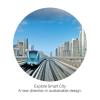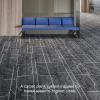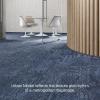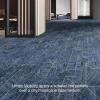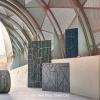SOURCE: Mohawk Industries
DESCRIPTION:
“Alexa, play the DesignFWD podcast.”
Welcome to DesignFWD, a podcast series presented by Mohawk Group, where we discuss innovations in design, performance, and sustainability that positively impact the built environment. Stick around for engaging conversation with our design leaders, sustainability advocates, and progressive end users who are moving design forward.
For our second episode, “Connecting Each Other Through Design’’, we are joined by Stacey Gerbman, Northeast Field Designer for Mohawk Group, to chat about how transit systems of smart cities influence wayfinding, the connection between rivers and cities – and how we can connect with each other through design.
Read the Episode Transcript
Elizabeth Bonner (EB): Hello and welcome. I’m Elizabeth Bonner, director of healthcare, senior living, education, government, and hard surface segments here at Mohawk Group.
Seth Brewer (SB): And I am Seth Brewer, product director for Mohawk Group.
EB: And we’re excited to have you join us for the second episode of our podcast series. For today’s episode, “Connecting Each Other With Design,” we’re joined by Stacey Gerbman, Northeast Field Designer of Mohawk Group, to chat about the Smart City collection and how design innovation is connecting people.
SB: This is going to be a fantastic conversation. Stacey is amazing, so let’s get started. Welcome, Stacey! Thank you for joining us today. Let’s start off by having you share a little bit about your background with our audience first off. Tell us about yourself and your role at Mohawk Group. I know you’ve been behind some of our more recent fantastic collection launches, but give us a little bit of your background.
Stacey Gerbman: Well, thanks, Seth. I’m really happy to be here this morning. It’s great to be with other people whenever we can right now, so thank you for inviting me. So, yeah, this is going to be my twenty-first year in the industry actually. I started my career actually in L.A., where I got my textile degree and worked for Bentley Prince Street for quite a while. And then I slowly but surely have migrated east over the past twenty years and was really excited to land at Mohawk Group as a Field Designer here. Really, you know, from the get-go, it’s really felt like a home. Everyone’s been so wonderful, our clients, our reps, our team…it’s been really great. I’m so happy to be here.
And I work on a lot of different types of projects with, you know, my first priority as a Field Designer is our clients. Certainly, I’m working on a lot of custom projects. Any type of design service that they need, I attend to here in the Northeast. But I’ve also been lucky enough to work on the regular product development projects or running line styles, which is really great because I get to use, kind of, my knowledge (information I’m collecting in the field here) and kinda pour that information back to the team. And, you know, we use that to develop some new products. So it’s exciting to work, kind of, across both custom and standard development planes, if you will.
SB: Absolutely. That’s definitely a double-edged sword, and we want to take advantage of your skillset in both of those aspects, so that’s a good comment, there.
EB: And it is very true. Stacey’s brought a wealth of knowledge to the team, and it’s been really a breath of fresh air to have her. Because it’s an interesting team that we have, everybody kind of brings something different to the table. So it’s very seldom that we bring anything to market that Stacey doesn’t touch because we’re always seeking her expertise in certain areas. But Mohawk launched the Smart City collection, actually, in 2020. Can you explain to us what Smart City is?
Stacey Gerbman: Yeah! In the simplest terms, a “smart city” is a city that uses technology to provide services and solve problems, so smart cities do things like improve transportation and accessibility, improve social services, promote sustainability. It gives citizens a voice.
Technology, as we know, is just advancing, you know, at a faster clip than any of us could ever imagine. And what this technology is being harnessed for are things like intelligent traffic signals, which can reduce commuting time by 15 to 30 minutes a day, or automated buildings that use dynamic electricity pricing that can reduce emissions by 10 – 15 percent. Also, real-time crime-mapping technology, that can aid in reducing crime, they’re finding, by 30 – 40 percent. So advancing cities are really getting on track with this technology to just, kind of, improve the experience for citizens, you know, like, per square foot, which is really amazing.
EB: What is the purpose of the Smart City collection? Can you explain how the product is connecting people through design?
Stacey Gerbman: Yeah, so Smart City was such an interesting project because it was inspired by transit systems from some of the world’s most, you know, connected cities — cities like London and Manhattan and Berlin and Paris. And while we know the last year certainly has been challenging and everything is very different right now, we know as we move through this together, that we’re looking forward to rebuilding our cities stronger than ever. And with that rebuilding, there’s definitely lots of indicators that by 2050, it could lead to 7 out of 10 people living in urban areas where rail will be the most used. So that fact kind of came to light and was really interesting to us when we started looking at, you know, what this collection was going to be about.
And that being said, we built the collection itself to work as a system that you can expand and contract depending on your needs, so the line work — there’s a base and then there’s a line work piece — so Urban Model is a textural base and it looks like a topographical map, if we’re hovering above the city, you know. And then Urban Mobility uses the accent lines of the transit lines, if you will, to build out new networks of space. We really wanted a collection to work like transit works — it moves you through a space in different ways. And we wanted to use color and pattern to do that, and have it work as seamlessly as possible.
The other really exciting thing about this collection, is the ability to personalize it so easily. And for such a low minimum, so for 500 square yards, you can really connect through color to a particular project or to a particular city, if you will, and that really gives us that ability to build that connection on so many different levels. You know, how we’re using the patterning through a space and then also how we’re using the color through the space and how it connects to people and the location it’s going.
SB: It really is quite fascinating, the connectivity between humans and the space they live in and these cities, and how we maneuver and get around…that relationship is just amazing. There’s also other relationships we care about, right? Water, for instance: the relationship between humans and our need for water and for water conservation. A lot of the efforts that Mohawk puts forward, such as our showerhead donations that we’ve done and exciting partnerships around the world to conserve water. We’re always being cognizant of our relationship to rivers and water in our built environment. So what is the relationship — Stacey — can you define the relationship between our cities and the surrounding water or the rivers?
Stacey Gerbman: Yeah, that’s a great question. So if you think about it, most of the oldest cities in the world have been developed around rivers because they played a major role in sustaining the city itself. Rivers provide water, they support natural processes, like flood prevention we know is so important. They provide habitats for plants and animals. And these are really important to a city, like plants, for example, have a cooling effect and they help lower the surface and air temperatures by providing shade and releasing moisture into the air. The river feeding that plant life is so crucial to a city’s ability to survive and thrive. They also manage floods, as most of the plant species that grow along riverbanks absorb a lot of water. So reducing flood energy, which is a threat to people and buildings, as we know, is really important.
And rivers ultimately connect communities, and they create opportunities for recreation. They really bring people together, and it’s really interesting doing the research, you know. I’ve found that half of the U.S. population lives in a coastal city or within a hundred miles. So that really says a lot about our attraction, I guess, to the water. And unfortunately, all too often, we see that the explicit value of rivers has been ignored or overlooked by policy makers. One of the things I think that Mohawk really understands is the value of the river. You know, we’re even named after one, right? So I think we have a different perspective on it.
EB: Rivers have become a really large conversation amongst our design team. I think Smart City really kicked that off. It has rolled into a much larger conversation, a lot of examination of how we all connect with water, and it’s led to a lot of really thought-provoking ideas that we’re going to be pushing forward in the next year. So it’s exciting to know that we’ve got a lot more to come about Mohawk and water and rivers, so something to look forward to.
But back to Smart City! I’m getting too into rivers, sorry. To circle back to Smart City, it has gotten a whole lot of attention in the market and won several awards. I know among those, it was a HiP Award winner, the #METROPOLISlikes Award at Neocon this year, as well as being a finalist at Design Week in New York. So what do you think contributes most to this product’s success so far and where do you see it going from here?
Stacey Gerbman: That’s a really interesting question…and a little bit of a hard question, you know, because a lot of success is partly timing — being able to gauge what’s necessary for the now. But I think ultimately, I want to answer that question with “flexibility.” I think the fact that Smart City does tick off a lot of boxes for people. It’s not just aesthetics. It’s the sustainability — the strong sustainability component — as well, and the sustainability of the design and the product itself being a system product, I really feel like Mohawk is unique in the marketplace, designing products that really work together as a system. Certainly, the individual patterns can be used independently, but having that unique system really provides a lot of great flexibility for how you can use the product in a space that I really think truly has contributed to its success.
Our designers have to pivot all the time — they really need products that can pivot with them, and I think Smart City is that. You know, the flexibility is there, the capability to personalize is there, the value with the sustainability component is there, and it’s nice to look at, too. It all adds up to something that people are really excited about, and I’m really proud to provide that.
SB: And you mentioned, Stacey, Smart City and all its different features and attributes and awards, but let’s talk a little bit more about the sustainability component, and that’s the fact that it’s Living Product Certified. Can you explain the product sustainability attributes that this carries?
Stacey Gerbman: So Smart City is a tile collection that’s manufactured at our Glasgow, VA, plant, and what’s really amazing about this plant is it’s the first in our industry to be certified as a Living Site. And achieving this was truly no small task. It takes many types of innovation — in materials and manufacturing and the community — to reach this goal. We’re actually the first one in any industry, I believe, to earn this certification for this particular plant. So that is really exciting for us.
And also Smart City is our first carbon net neutral product where we’re not contributing to any harmful carbon emissions, so this is one of the big tenets of Smart City, where we collectively need to reduce carbon emissions by 2030 in order to help stop the damage from climate change. Gensler, who was our partner in designing Smart City, has written a lot about and embraced AIA’s 2030 Carbon Challenge. And Mohawk is in alignment with this. So now any products coming out of our Living Site in Virginia will be carbon positive, which is a term we use for being carbon net neutral if you’re reducing your footprint and then teaching others to reduce their footprint. So all of this adds up to a really strong and exciting sustainability story for Mohawk and for Smart City.
EB: Yeah, I say this way too often, I’m sure, but our sustainability side of things at Mohawk is probably what makes me more proud than any of the product, even, that we launch. It’s important that manufacturers have to take the lead to be stewards of the environment, and it’s a proud moment when you can say that you work for a company that does.
SB: Absolutely, absolutely. And, Stacey, as always, it’s been fascinating learning about this collection, talking to you more, discovering more about your background and about all the Mohawk collections and attributes that we bring to market. It’s been a great conversation, so thank you.
EB: Thanks, Stacey.
Stacey Gerbman: Thank you, guys.
Subscribe to our podcast to receive the latest updates on trending topics brought to our conversations.
See the products referenced in this podcast here!
KEYWORDS: NYSE:MHK, Mohawk, DesignFWD, Smart Cities
